
Potamididae, common name potamidids are a family of small to large brackish water snails that live on mud flats, mangroves and similar habitats. They are amphibious gastropod molluscs in the superfamily Cerithioidea.

The Cerithioidea is a superfamily of marine, brackish water and freshwater gastropod containing more than 200 genera. The Cerithoidea are included unassigned in the subclass Caenogastropoda. The original name of this superfamily was Cerithiacea, in keeping with common superfamily endings at the time.
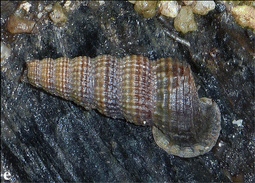
Cerithidea is a genus of medium-sized sea snails or mud snails, marine gastropod mollusks in the family Potamididae, the horn snails.

Pirenella cingulata is a species of medium-sized sea snails or mud snails, marine gastropod mollusks in the family Potamididae, the horn snails.

Heterophyes heterophyes, or the intestinal fish fluke, was discovered by Theodor Maximaillian Bilharz in 1851. This parasite was found during an autopsy of an Egyptian mummy. H. heterophyes is found in the Middle East, West Europe and Africa. They use different species to complete their complex lifestyle. Humans and other mammals are the definitive host, first intermediate host are snails, and second intermediate are fish. Mammals that come in contact with the parasite are dogs, humans, and cats. Snails that are affected by this parasite are the Cerithideopsilla conica. Fish that come in contact with this parasite are Mugil cephalus, Tilapia milotica, Aphanius fasciatus, and Acanthgobius sp. Humans and mammals will come in contact with this parasite by the consumption of contaminated or raw fish. This parasite is one of the smallest endoparasite to infect humans. It can cause intestinal infection called heterophyiasis.

Pirenella alata is a species of sea snail, a marine gastropod mollusk in the family Potamididae. It also lives in brackish water.

Cerithidea decollata, common name the truncated mangrove snail, is a species of sea snail, a marine gastropod mollusc in the family Potamididae.
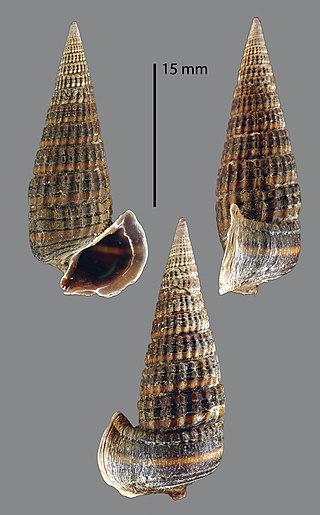
Pirenella microptera is a species of snail, a brackish-water gastropod mollusk in the family Potamididae.
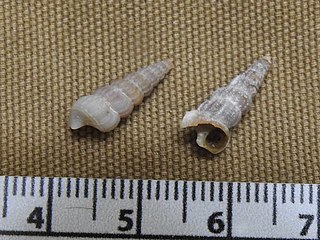
Cerithideopsis scalariformis, commonly known as the ladder hornsnail, is a species of sea snail, a marine gastropod mollusk in the family Potamididae. This amphibious species occurs in the western Atlantic Ocean, the Caribbean Sea and the Gulf of Mexico. The maximum recorded shell length is 33 mm (1.3 in).
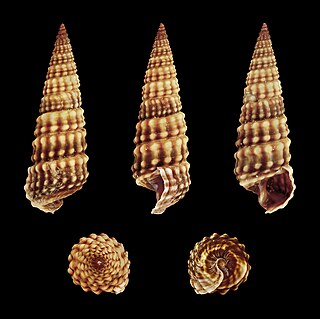
Cerithideopsilla conica is a species of small sea snail, a marine gastropod mollusk in the family Potamididae.
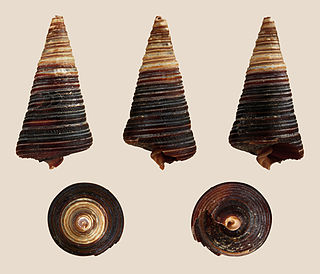
Telescopium telescopium, commonly known as the telescope snail, is a species of snail in the horn snail family Potamididae found in mangrove habitats in the Indo-Pacific. They are large snails that can grow up to 8 to 10 cm in length and are easily recognizable by their cone-shaped shell.

Terebralia palustris, common name the giant mangrove whelk, is a species of brackish-water snail, a gastropod mollusk in the family Potamididae. This tropical species which inhabits mangrove environments of the Indo-West Pacific region, has the widest geographic distribution amongst the potamidids extending from eastern Africa to northern Australia. Terebralia palustris is the largest mangrove gastropod, with a maximum shell length of 190 mm recorded from Arnhem Land, Australia.
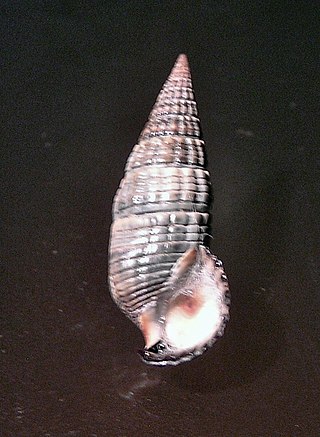
Terebralia semistriata, common name the striate mud creeper, is a species of sea snail, a marine gastropod mollusk in the family Potamididae.
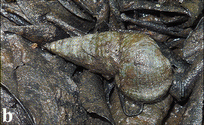
Terebralia sulcata is a species of sea snail, a marine gastropod mollusk in the family Potamididae.

Tympanotonos fuscatus, the West African mud creeper, is a species of snail living in brackish water, a gastropod mollusk in the family Potamididae.

Potamides is a genus of prehistoric sea snails, marine gastropod mollusks in the family Potamididae.

Telescopium is a genus of cone-shaped sea snails in the family Potamididae.

Cerithideopsis californica, common name the California hornsnail or the California horn snail, is a species of sea snail, a marine gastropod mollusk in the family Potamididae. This series was previously known as Cerithidea californica.

Pirenella is a genus of sea snails, marine gastropod mollusks in the family Potamididae.

Cerithideopsilla is a genus of medium-sized sea snails or mud snails, marine gastropod mollusks in the family Potamididae, the horn snails.



















